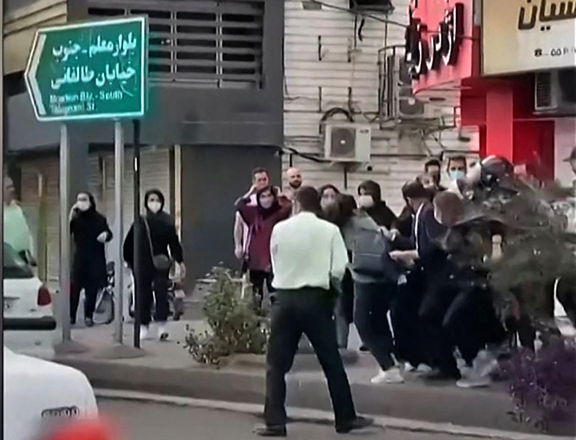You are here
Tear gas fired as Iranians rally over Mahsa Amini's death
By AFP - Oct 12,2022 - Last updated at Oct 12,2022
PARIS — Iranian security forces fired tear gas Wednesday at a lawyers' protest over Mahsa Amini's death, said a rights group, which also raised the death toll to at least 108 from the crackdown on the nearly month-long movement.
"Woman, life, freedom," the lawyers in Tehran chanted in their first solidarity rally with the women-led demonstrations that have swept Iran since the 22-year-old's death, said Oslo-based Iran Human Rights.
Soon after, they were seen running from under a cloud of tear gas, in footage distributed online by IHR despite a major Internet outage, and one lawyer later said three of the demonstrators were arrested.
Amini, an Iranian of Kurdish origin, died on September 16 after falling into a coma following her arrest in the capital by the morality police for an alleged breach of the Islamic republic's strict dress code for women.
Young women, university students and even school girls have since defiantly removed their hijabs and faced off with security forces in the biggest wave of social unrest to grip Iran in almost three years.
At least 28 children have been killed in the protests, and hundreds more detained and held mostly in prisons for adults, rights groups inside and outside the country said.
Deadly unrest has rocked especially Sanandaj in Amini's western home province of Kurdistan — but also Zahedan in Iran's far southeast, where demonstrations erupted on September 30 over the reported rape of a teenage girl by a police commander.
Supreme leader Ayatollah Ali Khamenei, in a televised appearance on Wednesday, again accused Iran's "enemies" of stoking "these street riots".
"The actions of the enemy, such as propaganda, trying to influence minds, creating excitement, encouraging and even teaching the manufacture of incendiary materials, are now completely clear," he said.
'Impending bloody crackdown'
Activists in Tehran called for protesters to turn out "in solidarity with the people of Sanandaj and the heroic people of Zahedan".
“We don’t want spectators. Come and join us,” sang a group of mainly young women as they clapped at a roundabout in Tehran’s Azad University, in other footage posted on Twitter by IHR.
The protest slogan “Woman, Life, Freedom” was spray-painted on the wall of the former US embassy — abandoned in the wake of the 1979 Islamic Revolution and subsequent hostage crisis — but later painted over, an image obtained by AFP showed.
Shops were shuttered in Sanandaj, and people rallied on the streets chanting slogans and waving hijabs in Tehran, Isfahan, Shiraz and Mashhad, in other online footage.
Iran Human Rights said the crackdown has killed at least 108 people, and that at least another 93 people died in Zahedan.
The Norway-based group indicated its investigation into the “repression” in Kurdistan had been hampered by internet restrictions and warned of an “impending bloody crackdown” there.
IHR also said workers had joined protest strikes this week at the Asalouyeh petrochemical plant in the southwest, Abadan in the west and Bushehr in the south.
Analysts say the multifaceted nature of the protests has complicated state attempts to quell them, which could spell an even bigger challenge to the authorities than the 2019 unrest.
In its widening crackdown, Iran has blocked access to social media, including Instagram and WhatsApp, and launched a campaign of mass arrests.
Online monitor NetBlocks on Twitter reported a “major disruption to internet traffic in #Iran” from around 9:30am (06:00 GMT) which was “likely to further limit the free flow of information amid protests over the death of #MahsaAmini”.
Children in adult prisons
The Tehran-based Children’s Rights Protection Society, which reported a death toll of 28 for minors, condemned security forces for violence against children.
It criticised “families being kept in the dark on their children’s whereabouts, cases proceeding without lawyers and a lack of children’s judges and police”, and said the government must be held accountable.
Revolutionary Guard deputy commander Ali Fadavi told Iranian media on October 5 that the “average age of the detainees from many of the recent protests was 15”.
Human rights lawyer Hassan Raisi said around 300 people between the ages of 12 and 19 are in police custody, some of them in detention centres for adult drug offenders.
In addition, Iran’s judiciary said more than 100 people had been charged over the Amini protests in Tehran and Hormozgan provinces alone.
Iran said an investigation found Amini had died of a longstanding illness rather than reported beatings.
Her bereaved parents have denied this and filed a complaint against the officers involved. One of her cousins, living in Iraq, has told AFP she died of “a violent blow to the head”.
Related Articles
PARIS — Gunshots were fired as Iranian security forces confronted protests on Wednesday over Mahsa Amini's death in a crackdown that rights
PARIS — Students led the way on Saturday in protests across Iran over Mahsa Amini's death, even as the commander of the powerful Revolutiona
PARIS, France — Iranian protesters rallied again on Sunday, defying an order by the powerful Revolutionary Guards to stop the demonstrations
















